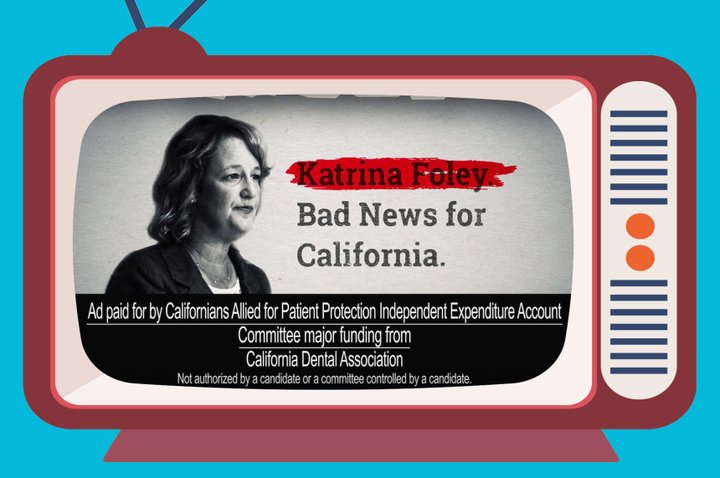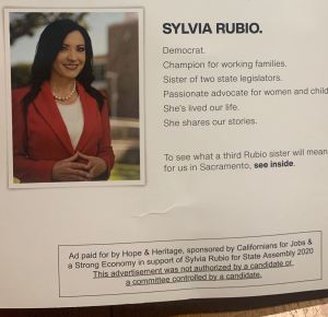
Under a California campaign finance loophole, the committee Californians Allied for Patient Protection is not required to list three industry groups that contributed $49,000 each as “major funding” sources. Illustration by Anne Wernikoff for CalMatters.
###
If you’re a voter in east Los Angeles County, there’s a chance there’s a glossy ad sitting in your mailbox right now that touts Sylvia Rubio, a candidate in one of the hottest races for the state Assembly, as a “passionate advocate for women and children” who has “lived our life” and “shared our stories.”
Read the mailer carefully and you’ll see in the fine print at the bottom that the “our” refers to the inoffensively named “Hope & Heritage” committee, which paid for the ad. But here’s what you won’t see: Hope & Heritage is primarily funded by an industry group that includes the pharmaceutical industry and one of the largest dialysis clinic operators in the state.
California legislators tried to cast some sunlight on anonymously funded dark money groups in 2017 when they passed a law requiring these independent expenditure committees to list their major donors on the political ads and mailers they pay for.
Such committees, generally funded by major corporate or labor organizations with business before the state, can legally raise and spend unlimited sums to boost or tear down a candidate so long as they don’t coordinate with a campaign.
But three years after passage of the “Disclose Act,” a number of the bill’s fiercest supporters now say the law contains a loophole big enough to drive a $50,000 truck through.
Here’s the catch: These committees are required to list a funder as a “top donor” on their ads only if that contributor has given at least $50,000. If donors give, say, $49,000, then their names need not be disclosed on the ads.
“These examples of deceptively named campaign committees hiding their top funders by having them contribute $49,000 shows that we might have to revisit that threshold for local and legislative campaigns.”
— Trent Lange, president of California Clean Money Campaign
So far, the top contributors to Hope & Heritage, the committee backing Rubio, are the Pharmaceutical Research & Manufacturers of America and Fresenius Medical Care, one of two major operators of dialysis clinics across the state, and a long-term target of unionization efforts.
The drug manufacturers gave Hope & Heritage $49,500, just $500 shy of the disclosure threshold. Fresenius gave $45,000.
The origins of Hope and Heritage trace back to yet another independent expenditure group that sponsored its creation — a committee called Californians for Jobs and a Strong Economy. It gave Hope & Heritage $49,500 in late January, but three weeks later Hope & Heritage for some reason refunded that contribution. Californians for Jobs and a Strong Economy has been a long-lasting backer of moderate Democrats — it’s already spent more than $300,000 to back Rubio, helping make her the single largest beneficiary of independent expenditure of any legislative candidate,
Who’s funding Californians for Jobs and a Strong Economy? Primarily big business interests, including Sempra Energy (parent company of San Diego Gas & Electric), Chevron, PhRMA and Walmart. Californians for Jobs and a Strong Economy has already spent more than $300,000 to back Rubio

Strategically setting a donation level to avoid the state’s transparency law is, of course, perfectly legal.
Trent Lange, president of the California Clean Money Campaign that spearheaded the drive for the 2017 transparency law, said that’s the problem.
Contributions coming in just shy of the threshold are “obviously a cynical ploy,” he said. While an earlier version of the bill did not include the $50,000 minimum, he said the exemption was carved out as a necessary compromise to get it through the Legislature, over the objections of both labor and business groups.
“These examples of deceptively named campaign committees hiding their top funders by having them contribute $49,000 shows that we might have to revisit that threshold for local and legislative campaigns,” he said.
David Townsend is the political consultant who runs Californians for Jobs and a Strong Economy. Asked whether the Hope & Heritage committee was established to obscure the mailer’s financial ties to politically unpopular industries, he said that “that’s probably accurate,” — but also stressed “if it’s under $50,000, you don’t have to disclose who they are.”
He referred additional questions to his colleague, Chris Tapio, who he said is running the committee. Tapio responded to a series of questions by emailing a link to a political advertising disclosure fact sheet published by the Fair Political Practices Committee, the state’s campaign finance watchdog.
“It’s a classic shell game”
It’s easy to see why some of the groups backing Rubio might be eager to keep their names off of mailers associated with the candidate.
She’s in a crowded race to replace Assemblyman Ian Calderon, who is retiring. Her most formidable candidate is the incumbent’s stepmother, Lisa Calderon, who has been aided by hundreds of thousands of dollars from organized labor. In recent weeks that spending has taken the form of mailers drawing attention to some of Rubio’s friends in industry.
“You can tell a lot about a candidate by the support they get,” read one mailer. “Sylvia Rubio is supported and funded by oil companies, oil refineries, & billion dollar drug companies.”
Channeling money from one committee to another and setting contributions below the $50,000 disclosure limit is a common “branding maneuver,” said Doug Morrow, a Democratic political researcher who runs DSM Analytics.
“What’s the advantage of spinning off the separate PAC (political action committee) unless you want to insulate some of your donors?” he said. “It’s a classic shell game.”
Hope & Heritage is certainly not the only independent expenditure group not publishing a full list of its top donors on its ads, as a result of contributions just below the legal limit.
In two of the most fiercely competitive state Senate races, a committee called Californians Allied for Patient Protection has spent more than $300,000 opposing two Democrats: Sally Lieber, a liberal former member of the Assembly in Silicon Valley, and Katrina Foley, the mayor of Costa Mesa.
“It’s such a trip down the rabbit hole that the oil companies can say that ‘You’re a fake environmentalist’ and the pharmaceutical industry can say that ‘You’re in the pocket of the drug manufacturers.’ ”
— Senate candidate Sally Lieber
The committee is backed by health industry groups hoping to protect a 40-year-old law capping the damages that can be awarded in medical malpractice suits. Pitting health care industry groups against trial lawyers, the battle over the Medical Injury Compensation Reform Act is likely to be one of the fiercest of 2020.
The committee’s ads feature a single major donor: the California Dental Association, which has poured $125,000 into the committee’s coffers.
Other donors include the Cooperative of American Physicians, a medical malpractice insurance provider, a committee sponsored by Kaiser Permanente and the California Medical Association, a trade group for the state’s physicians.
Each contributed $49,000.
“That’s honestly not our motivation”
Anthony York, a spokesperson for the California Medical Association, said there was no significance to the group’s $49,000 contribution. He pointed out that the association has already spent well above the mandatory disclosure threshold in support of Shelly Masur, one of Lieber’s Democratic opponents in the race.
“We are not shy about our political support and activity,” he said. “Can’t speak to other groups but that’s honestly not our motivation in our political decisions.”
Lisa Maas, executive director of Californians Allied for Patient Protection, did not respond to a series of messages.
Another committee, Driving California’s Economy — this one funded by the California New Car Dealers Association — chipped in $40,000.
“I think most of these special interests, if they can avoid putting their name on a piece, they will,” said Lieber, one of the committee’s targets who is running to replace Sen. Jerry Hill.
She added that she would support amending state law to require committees to publish the names of their top three contributors, regardless of contribution size. Allowing committees to “game the system” by concealing who is funding what breeds cynicism among voters, she said.
“It’s such a trip down the rabbit hole that the oil companies can say that ‘you’re a fake environmentalist’ and the pharmaceutical industry can say that ‘you’re in the pocket of the drug manufacturers,’” Lieber said. “Everyday people that have busy lives just give up after a while and think, ‘How do I know about any of these people?’ That’s what the corporations are betting on.”
“Who the hell would want their name on a f — ing mailer?
—Political consultant Jim Stearns
It isn’t just corporations who are taking advantage of California’s campaign finance loophole by making donations that slide just under the amount triggering the state’s disclosure requirement.
The East Bay city of Livermore is the center of a particularly fractious campaign over whether to approve a downtown development plan with a hotelier. (How fractious? In late January, an unknown vandal stunk up a “Yes on P” campaign with a “fart bomb.”)
According to campaign finance documents filed with the city, the four largest backers of the “No on P” campaign are Joan Seppala, publisher of the local weekly the Livermore Independent; her husband Lynn; Jean King, chair of the Livermore Valley Performing Arts Center board; and Barbara Sweet, a New Hampshire resident.
All four gave $49,000.
Jim Stearns, a San Francisco political consultant hired by the campaign, said there wasn’t anything remarkable about that choice of contribution size.
“The most common contribution in the world is right under the disclosure requirement,” he said. “Who the hell would want their name on a f — ing mailer? The state makes the rules. They’re following the rules.”
###
CalMatters reporter Laurel Rosenhall contributed to this story.
Don’t miss CalMatters’ voter guide to the 2020 California primary.
CALmatters.org is a nonprofit, nonpartisan media venture explaining California policies and politics.
CLICK TO MANAGE